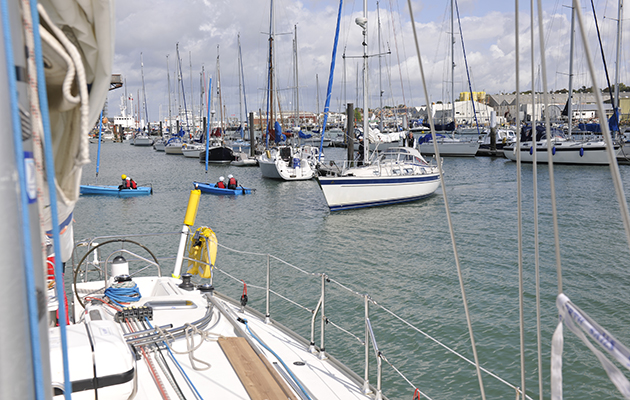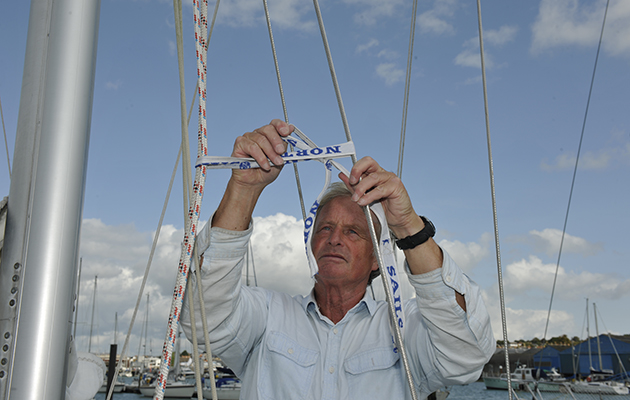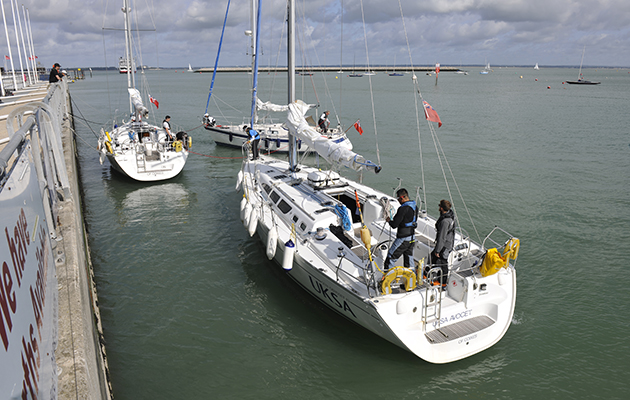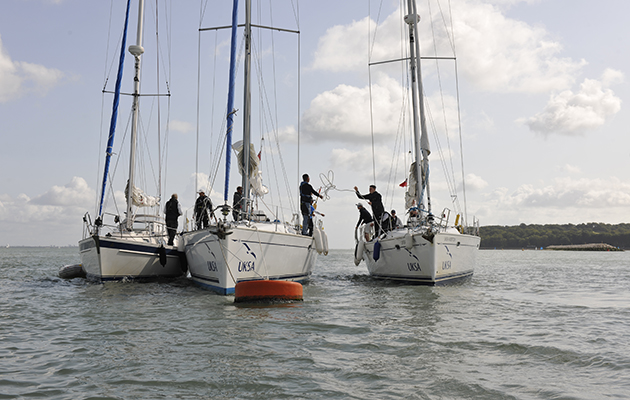James Stevens looks at the seamanship and etiquette needed to raft up and identifies the benefits and pitfalls of coming alongside
One of my most memorable nights in a raft was in Guernsey alongside a Polish yacht, which looked as if it had been welded from scrap from the Gdansk shipyard.
We communicated by smiling and proposing toasts.
The ebullient and enthusiastic crew drank a clear, viscous liquid that, along with my scotch, gave me a three-day hangover.
It is surprising how often you can end up in a raft with someone you have met previously on your travels.

Credit: Liza Sawyer
It is one of the great pleasures of sailing and the majority of yachtsmen welcome you alongside and couldn’t be more helpful.
I have also had some forgettable experiences alongside the ‘lads on tour’, who thought yachting involved playing music in the cockpit and braying with laughter until 4am.
While antisocial neighbours can test your patience, the weather can provide more serious challenges.
It can cause serious damage to your topsides and most skippers will have experienced nights rafted when they have been kept awake checking their squeaking boat fenders and warps, fretting about the sharp pull of yachts outside straining the cleats.
I can recall crossing the Channel from Cherbourg in a strong northeasterly.
We were trying to get to the Solent but Weymouth ended up as the simplest option.
I expected Weymouth, on a weather shore, to be pretty calm but the harbour entrance faces north-east and a very tired crew spent an unhappy night on a very lively raft.
So, before committing to a harbour, it is essential to take a good look at the weather and read the pilot book, which warns you of uncomfortable wind directions.
How to raft against tidal walls
Rafting on tidal walls is much less common than it used to be.
Popular harbours such as Poole and Weymouth now have marinas and pontoons that make rafting much easier.
If you end up on a tidal wall, especially with a big range, the inside yacht needs to take a lot of care with the lines.

Moor such that the ladder is not next to your cockpit. Note the fenderboard — which is essential — and the line to the ladder so you can haul the boat into the ladder if needs be. Credit: Lester McCarthy
Choose a spot with a handy ladder, which the outside crew can get to without walking across your cockpit.
Use long bow and stern lines and springs.
This means you have less slack at high water.
Tension the lines at low water so slack is kept to a minimum.
The outside yacht needs long shore lines too, and also needs to tension them at low tide.

Before finishing the mooring process, use the springs to make sure that the rigs are misaligned so that they can’t crash together in a chop. Credit: Lester McCarthy
Fenderboards are essential if the wall has projecting piles but are also useful to distribute the weight on several fenders.
If the yachts are being blown offshore it’s worth having a line attached to the ladder that can be used to pull or winch the yacht to within reaching distance.
Obviously this line has to be kept slack when not in use.
How to join a raft
Rafts are generally formed between friends, yachts on rallies or when harbours are busy.
There are usually willing helpers to assist your arrival and departure, but there are some important seamanship skills and courtesies to consider.
An inadequately fendered yacht arriving noisily in the middle of the night complete with shouting crew and huge bursts of power is an unwelcome alarm bell.

Motor past first to assess the situation before you come alongside. Credit: Lester McCarthy
In a strong onshore wind a badly secured yacht outside can seriously damage your topsides and toerail, particularly if you happen to end up on the inside of several boats.
Once you are in this situation for the night there is virtually no escape.
Although your fellow skippers are as awake as you are, very few will pull on their wet weather gear and decide enough is enough and push off somewhere else.
Size of the party
The wind direction makes a huge difference to the comfort of any alongside berth but the problems are magnified in a raft.
If the forecast is for strong onshore winds, go and find a berth where you are being blown away from the pontoon or wall, or skip the pontoon party and save your topsides.
Most marinas limit the size of rafts on their outer hammerhead pontoons, usually three, and harbourmasters can also limit rafting on harbour walls.
This works well while harbour or marina staff are on duty, but if you are outside a raft there can come a point where an additional yacht is one too many.

Harbourmasters will decide when a raft is full and prevent any further boats rafting, usually with a sign like this. Credit: Lester McCarthy
If you have established that there is a rule, then you are on strong ground to decline politely a request from an approaching yacht.
If not, the usual solution is to place your dinghy alongside.
I think any raft larger than five is going to become unstable if there’s a breezy night ahead and incomers should understand this.
You can predict that some harbours are going to be full — Yarmouth on August bank holiday, for example.
Most ports have an alternative anchorage or harbour but some don’t, so research is essential.

If your shore line looks likely to foul the bow or stern of another boat, use a rolling hitch to rig a short spring. Credit: Lester McCarthy
Having decided rafting is an option, pick on someone your own size or larger.
As you approach look at how the inside yacht is secured and fendered.
The safety of your yacht is going to depend to some extent on whether the inside yacht understands how to secure alongside.
It’s worth motoring past to check the tidal conditions, availability of cleats and secure points and to request permission to come alongside.
Some racing yachts have few cleats, and stanchions or shrouds are a poor substitute.
The approach and alongside
As with any alongside berth, have your fenders at the right height, approach slowly with a bow and stern line and preferably a back spring ready to prevent the tide or wind setting your yacht astern when you stop.
If you have to find your way in between two rafts, the tidal stream lets you ferry glide sideways without moving forwards.
Take your time with occasional burst of ahead and angle the bow slightly across the stream.
Once alongside, spend some time organising your warps to create minimum disruption and spare line on your neighbour’s boat.
Cleats mostly end up pretty busy in rafts, so a bowline on the inside yacht is much more efficient than cleating up with turns.
I prefer to use four separate lines because it makes adjusting the position of the yachts easier to ensure the rigs avoid each other when the wash from a motorboat arrives.

If you’re leaving the boat and the raft has been declared full, you can leave your dinghy outside to prevent further rafting. Credit: Lester McCarthy
Note that owners of boats with wooden toerails, and I’m one, are particularly twitchy about warps sawing through their lovely teak, so think very carefully about the lead of your springs.
Using a central cleat can be a solution.
If the cleats become full, springs can be secured by a bowline around a winch, but take care to ensure a fair lead back to your boat.
Move your fenders to the point of contact so the weight is taken by several rather than one.
Continues below…
How to sail to France from the UK
For home-waters sailors who are considering a holiday cruise to France, Ken Endean looks at the options for making a…
An expert’s guide to stern to mooring
If you charter in the Med, you’ll find yourself mooring stern to. Theo Stocker finds out how from Barrie Neilson…
Singlehanded sailing for the first time
Toby Heppell looks at the art of singlehanded sailing and considers what constitutes good seamanship when it’s only you on…
Man overboard: tactics that really work for couples
The YM team get wet to see how well the MOB process works for shorthanded sailing. Here are our findings...
Secure shore lines unless it is very calm and you have discussed the situation with the inside boat.
The purpose of shore lines is to reduce the weight on the cleats of the inside yacht.
They therefore need to be adjusted carefully to find a balance between doing nothing and your boat ending up supporting the inside ones.

Don’t forget to hang your fenders at toerail height rather than pontoon height. Once moored, bunch them all together. Credit: Lester McCarthy
Check them periodically; if it gets windy warps stretch and boats move a little. I prefer to use bowlines on the shore end of shore lines.
If the lead is poor you can use a spring to avoid contact with the inside yachts.
This is an extra line secured to your shore line with a rolling hitch, which pulls it away from nearby yachts.
The strain on the spring is not that great, so it can be a light rope.
The same principle can be used to pull warps away from chafe points such as toerails.
If you are using an electric cable give it plenty of slack to account for the raft moving on the turn of the tide, and wrap it around the warps to keep it clear of the water
Observe the courtesies to make life easier
When rafting you are living very close to one another so the situation can turn from social to antisocial pretty quickly.
If you want to stay on speaking terms with the inside yacht there are some important courtesies.
A good start is a polite request to come alongside.

Talk timings with the boat inside. If they have an earlier start, they may well prefer to go outside you. Credit: Lester McCarthy
If the answer is ‘I’m leaving at 4am’ a polite suggestion that you’re happy to go on the inside will hopefully get the polite reply of ‘OK, I’ll stand off and let you in.’
If you are the one who has to leave at 4am then a raft isn’t the ideal place to be, unless of course you are all waiting for the same tide and leaving together, which is quite common in ports such as Weymouth or Guernsey.
Very often on arrival the inside yacht will take your warps and secure them at a suitable strong point saving you the trouble of working out the best cleat.
If you are the inside boat you can ensure their lines are led to avoid damage to your boat. It always takes longer to secure to a raft to ensure you are happy with the position of boat and warps.
It also involves venturing into their cockpit, which requires permission and is forbidden territory (unless invited) from then on.

Once moored, only ever cross the foredeck. As the inside boat, cow hitch spare line and take sheets forward to minimise the trip hazards for crew from the outside. Credit: Lester McCarthy
You must always walk across another yacht’s foredeck.
Also, ensure your halyards are well secured and silent.
If you are inside, open your guardrail gate, if you have one, on both sides.
Clear your foredeck of as many obstructions as you can, such as paddleboards, to avoid the returning party animals outside you tripping up noisily in the middle of the night.
Secure the jib sheets from your roller furling headsail away from throat height and don’t leave miles of spare warp on the deck — cow hitch it to the rail.
If you are walking across a foredeck resist the temptation to peer down the forehatch.
If you are a dog owner, remember that not everyone loves them.
If you are the outside boat you might find it quicker, easier and more sociable to pull yourself in the dinghy to and from the pontoon along the shore lines.
Off and onshore
If it gets windy you won’t need an alarm, the movement of the boat and the creaking of warps and fenders will leave you in no doubt.
An offshore wind is much easier to deal with than an onshore wind.
You will probably have to adjust and tighten your lines, especially the shore lines; again this is much easier if you have used a separate warp for each job.

When rigging a bow or stern line involves entering the cockpit of the boat inside, always ask for permission. Credit: Lester McCarthy
If a warp is creaking and driving you to distraction a possible cure is to lead another warp in the same direction from another part of the boat, if you can.
Fortunately the sea is calm in this situation, so you have a reasonable chance of getting some sleep.
With an onshore wind, look carefully at the weather forecast and avoid joining a raft if the onshore wind is predicted to be strong.

Tight turns on warps can lead to excess chafe, and they can wear through in a night. Wrap round and secure a protective cloth with a light line. Credit: Lester McCarthy
There are plenty of horror stories of boats having holes knocked in their topsides from being trapped in this situation.
Before the breakwater was built, the outer pontoon in Cowes Yacht Haven was the scene of many a rafting disaster in a northeasterly gale.
Life on the outside
If you are the outside boat, slip and try to find another berth or mooring before it starts blowing hard — not just for your sanity but to relieve the pressure on the other boats inside you.
If you are caught inside use all your fenders bunched together to share the load as much as possible.
Nylon warps are the most elastic and reduce snubbing.
Look really carefully at the lead of your warps. They can chafe through in a night.

Make sure your halyards are frapped away from the mast so they don’t spend the night clanging against it. Credit: Lester McCarthy
Sometimes you can organise a good lead straight from cleat to cleat without the sharp turn of a fairlead.
If the lead has to be poor use padding to reduce abrasion.
A simple way of doing this is to secure a rag around the warp with light line.
It’s probably going to be rough so look up and check there is no contact aloft and adjust your springs if it looks likely.

If all the cleats are full, there will be other strong points on deck that can be used. A tugboat hitch on a winch or windlass will serve well if needs be. Credit: Lester McCarthy
There are big forces at work as a group of yachts squeeze together and warps take the load, so be really careful and tell your crew to take the normal precautions with feet and hands as the yachts come together, and ensure they take a turn round the cleat when handling warps.
Anti-snubbing compensators on your mooring lines can make a big difference.
Fender socks and fender mats also help, but the socks may end up being sacrificial on a bad day.
Handling winds parallel to the pontoon
In strong winds from the bow or stern the raft can assume an alarming banana shape.

Without another line long enough the outside boat is using its shore line as a new bow line, run around the bow of the middle boat, which is the one departing, to the inside boat. Credit: Lester McCarthy
Tensioning the lines doesn’t always straighten this and if the outer yachts are in danger of hitting the next raft or other obstruction, the only option, apart from trying to secure the shore lines at a better angle or disbanding the raft, is to start the engine and try to motor the raft against the wind.
It is not a comfortable way to spend the night.

The outside boat runs a new stern line around the bow of the middle boat and back to the stern of the inside boat. The line will be rigged when the middle boat has begun to leave. Credit: Lester McCarthy
How to leave a raft safely
Leaving the inside of a raft is reasonably straightforward in good weather but is infinitely more difficult in strong winds, particularly if there happen to be other rafts each side.
The difficulty is that you have to leave downtide, or if it is slack, downwind: the opposite way you would normally leave an alongside berth.
It is a manoeuvre that requires the cooperation of the crew of the next boat.

The middle boat has dropped its stern lines and is now slipping bowlines in readiness for leaving downtide, which means astern in this instance. Middle and outside boats have their engines running — just in case. Credit: Lester McCarthy
If you are unlucky enough to have chosen a time when there is no crew on the next boat, then you will have to leave one of your crew behind and pick them up later.
The remaining boats need a long warp.
If you are leaving astern because the tidal stream is coming from the bow, a line needs to be taken from a cleat near your stern on the outside boat, right around your bow, outside everything, to a cleat near your stern on the inside boat.

The middle boat has slipped and run astern out of the raft. With the new stern line now properly rigged, the outside boat begins to haul on both bow and stern lines to get back alongside the inside boat. Credit: Lester McCarthy
There will also need to be a line from a cleat near your bow on the outside boat to a cleat near your bow on the inside boat.
Release all your warps and as you slip out the remaining crews will tend the lines to pull the raft together again.
Providing the yachts are under about 40ft and the weather is gentle, quite a lot of this manoeuvre can be assisted by manpower and with a little help from the throttle.

Bow and stern lines are secured, followed by springs, then new bow and stern shorelines will be rigged to finish the job and attach the remaining yachts in a smaller raft. Credit: Lester McCarthy
Take it slowly and make sure you are well fendered down both sides.
Leaving any berth downtide requires a good awareness of what the tide is doing to the boat, so you need to take care that you are not swept on to another raft or lose control beam on to the stream as you break free.
How to raft on mooring buoys
In summer many harbours expect visiting yachts to raft up on swinging mooring buoys.
Unlike pontoons and walls, if the weather turns unpleasant it is reasonably easy to escape, providing the raft is secured properly.
Most harbours also put a limit on the number of boats on a swinging mooring.

Having asked to come alongside, bow and stern lines are passed to the central boat, then springs are rigged, making sure the spreaders won’t clash, starting things off badly. Credit: Lester McCarthy
Here again three is fine, five is OK in good conditions and anything above is pretty uncomfortable.
You need to consider what is going to happen when the tide turns.
In harbours such as Salcombe, rafting off the town on a flood tide with an onshore wind is quite comfortable, but can become unpleasant on the ebb.

All boats need to run their own mooring lines to the buoy, which is most likely to involve a tender. Credit: Lester McCarthy
In these conditions a better option is to move further up the harbour to more sheltered water.
You should, if possible, choose a similar sized yacht to go alongside.
After the normal courtesies and request, motor alongside and secure to the other yacht in the normal way.
The next part nearly always requires a dinghy to attach your boat to the buoy.
Ideally the buoy then sits between the two bows which has the advantage of not thumping the topsides when the tide turns.

Three approaches to mooring to a buoy: the middle boat has rigged a bridle, the boat on the left has rigged a round turn with a bowline long enough to be untied from deck. The boat on the right will need to be creative slipping its mooring. Credit: Lester McCarthy
If attaching to a ring on top of a buoy I prefer a round turn and a long bowline that I can tie and untie on deck.
The two yachts then take the weight equally.
If another yacht arrives, preferably on the other side, it too should secure to the buoy requiring all the mooring lines to be adjusted so the buoy is in its original position.

To leave the raft, again downtide, the middle boat slips springs, then stern and bow lines, then slips its mooring line and glides out gently, minding rigs. The two remaining boats glide together but don’t forget to fender the bow. Credit: Lester McCarthy
However many yachts arrive, they should all attach to the buoy.

James Stevens, author of the Yachtmaster Handbook, spent 10 of his 23 years at the RYA as Training Manager and Yachtmaster Chief Examiner
Everyone can then slip the raft independently.
The yachts are likely to roll when the wind and tide are opposed, so take care with the fenders and check the rigs are offset, as the crash of spreaders is a bad way to be woken up.
Dinghies normally fit quite comfortably in-between the yachts at the stern, but it is really important to check that the outboard is clear of everyone’s topsides.
If on the outside yacht I don’t usually put fenders out on the outside but I have a couple in reserve if I think my new neighbour requires it.
Some of my best evenings afloat have been spent alongside, sometimes with old friends and sometimes with new ones.
It can be one of the most enjoyable experiences in yachting but it can be one of the worst if you do not follow these essential steps and basic courtesies.
For all the latest from the sailing world, follow our social media channels Facebook, Twitter and Instagram.
Have you thought about taking out a subscription to Yachting Monthly magazine?
Subscriptions are available in both print and digital editions through our official online shop Magazines Direct and all postage and delivery costs are included.
- Yachting Monthly is packed with all the information you need to help you get the most from your time on the water.
- Take your seamanship to the next level with tips, advice and skills from our expert skippers and sailors
- Impartial in-depth reviews of the latest yachts and equipment will ensure you buy the best whatever your budget
- If you are looking to cruise away with friends Yachting Monthly will give you plenty of ideas of where to sail and anchor








